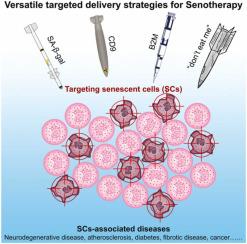Biomedicine & Pharmacotherapy ( IF 7.5 ) Pub Date : 2022-09-23 , DOI: 10.1016/j.biopha.2022.113737 Qixiong Zhang 1 , Shanshan Li 2 , Fengyu Chen 3 , Rui Zeng 2 , Rongsheng Tong 1

|
Numerous cutting-edge studies have confirmed that the slow accumulation of cell cycle arrested and secretory cells, called senescent cells (SCs), in tissues is an important negative factor, or even the culprit, in age- associated diseases such as non-alcoholic fatty liver, Alzheimer’s disease, type 2 diabetes, atherosclerosis, and malignant tumors. With further understanding of cellular senescence, SCs are important effective targets for the treatment of senescence-related diseases, called the Senotherapy. However, existing therapies, including Senolytics (which lyse SCs) and Senostatic (which regulate senescence-associated secretory phenotype), do not have the properties to target SCs, and side effects due to non-specific distribution are one of the hindrances to clinical use of Senotherapy. In the past few decades, targeted delivery has attracted much attention and been developed as a recognized diagnostic and therapeutic novel tool, due to the advantages of visualization of targets, more accurate drug/gene delivery, and ultimately “reduced toxicity and enhanced efficacy”. Despite considerable advances in achieving targeted delivery, it has not yet been widely used in Senotherapy. In this review, we clarify the challenge for Senotherapy, then discuss how different targeted strategies contribute to imaging or therapy for SCs in terms of different biomarkers of SCs. Finally, the emerging nano-Senotherapy is prospected.
中文翻译:

靶向给药策略:新兴senotherapy的有益合作伙伴
大量前沿研究证实,细胞周期停滞和分泌细胞(称为衰老细胞 (SCs))在组织中的缓慢积累是与年龄相关的疾病(如非酒精性脂肪)的一个重要负面因素,甚至是罪魁祸首。肝脏、阿尔茨海默病、2型糖尿病、动脉粥样硬化和恶性肿瘤。随着对细胞衰老的进一步了解,SCs成为治疗衰老相关疾病的重要有效靶点,称为Senotherapy。然而,现有疗法,包括 Senolytics(裂解 SCs)和 Senostatic(调节衰老相关分泌表型)不具有靶向 SCs 的特性,并且由于非特异性分布引起的副作用是临床使用的障碍之一的 Senotherapy。在过去的几十年里,由于靶点可视化、更准确的药物/基因递送以及最终“降低毒性和增强疗效”等优点,靶向递送引起了广泛关注,并被开发为一种公认的诊断和治疗新工具。尽管在实现靶向递送方面取得了相当大的进展,但它尚未广泛用于 Senotherapy。在这篇综述中,我们阐明了 Senotherapy 面临的挑战,然后根据 SCs 的不同生物标志物讨论不同的靶向策略如何有助于 SCs 的成像或治疗。最后对新兴的纳米Senotherapy进行了展望。尽管在实现靶向递送方面取得了相当大的进展,但它尚未广泛用于 Senotherapy。在这篇综述中,我们阐明了 Senotherapy 面临的挑战,然后根据 SCs 的不同生物标志物讨论不同的靶向策略如何有助于 SCs 的成像或治疗。最后对新兴的纳米Senotherapy进行了展望。尽管在实现靶向递送方面取得了相当大的进展,但它尚未广泛用于 Senotherapy。在这篇综述中,我们阐明了 Senotherapy 面临的挑战,然后根据 SCs 的不同生物标志物讨论不同的靶向策略如何有助于 SCs 的成像或治疗。最后对新兴的纳米Senotherapy进行了展望。



























 京公网安备 11010802027423号
京公网安备 11010802027423号